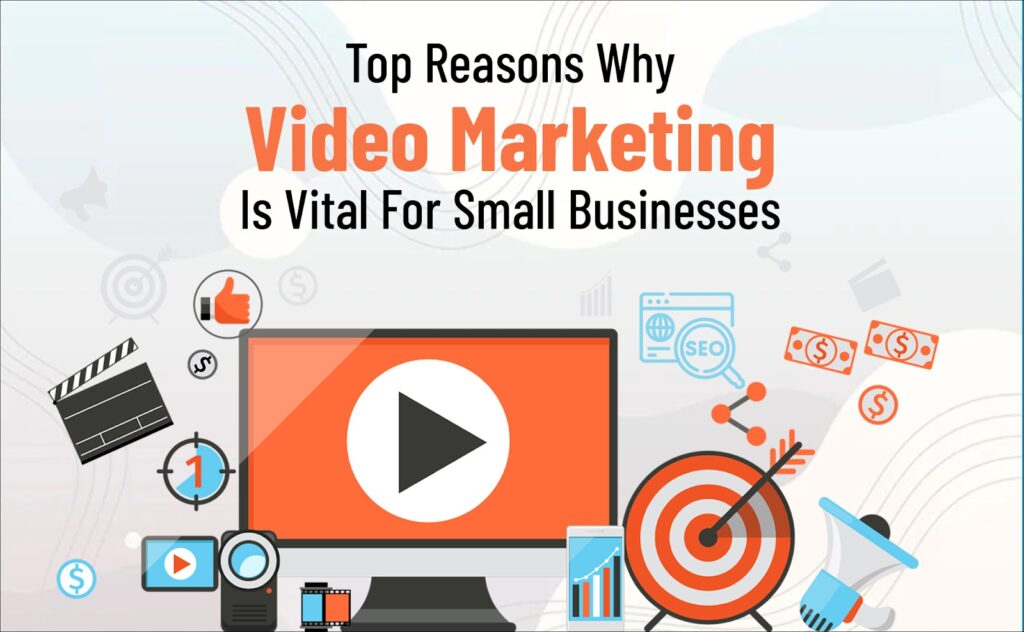Small businesses can excel in video marketing by focusing on storytelling to build connections, using cost-effective tools, and experimenting with diverse content like tutorials, product demos, and testimonials. Optimize videos for each platform, ensuring accessibility and SEO-friendly descriptions. Consistency and a content calendar help maintain engagement, while analytics tools track performance. Collaborating with influencers, repurposing content, and leveraging paid ads boost visibility. Community engagement and strong calls-to-action encourage interaction and sharing, effectively driving brand awareness and growth.
Define Your Goals and Audience:
Set clear goals for your video marketing efforts. Determine whether you want to increase brand awareness, drive sales, or educate your audience. Identify your target audience by understanding their demographics, preferences, and pain points. Tailor your video content to meet their needs and interests.
Video Marketing Focus on Storytelling:
Small businesses can stand out by telling authentic and relatable stories. Share your brand’s journey, highlight customer success stories, or showcase behind-the-scenes footage. Story-driven content builds emotional connections and trust with your audience, setting your business apart from larger competitors.
Leverage Cost-Effective Tools:
Use affordable tools like Canva, Animoto, or Kapwing to create high-quality videos on a budget. Smartphones can capture excellent footage, eliminating the need for expensive equipment. Free or low-cost editing software like DaVinci Resolve or iMovie helps polish your videos professionally.
Create a Mix of Content Types:
Experiment with various video formats to engage your audience, such as product demos, how-to tutorials, customer testimonials, and live streams. Short-form content like Instagram Reels, TikTok videos, or YouTube Shorts is great for quick engagement, while longer videos on YouTube or your website can dive deeper into your offerings.

Optimize for Each Platform:
Customize your videos for the platforms where your audience is active. Use vertical formats for Instagram, TikTok, and Snapchat, and horizontal formats for YouTube and Facebook. Add captions to make your videos accessible, as many viewers watch without sound. Optimize titles, descriptions, and tags for SEO.
Leverage Social Media and Ads:
Share your videos on social media platforms to reach a broader audience. Utilize features like Instagram Stories or LinkedIn posts to maximize visibility. For paid campaigns, platforms like Facebook Ads Manager allow precise targeting, ensuring your videos reach the right audience.
Consistency is Key:
Regularly upload videos to keep your audience engaged and aware of your brand. Develop a content calendar to plan and schedule videos in advance. Posting consistently helps establish your brand’s voice and keeps you top of mind for customers.
Encourage Engagement and Sharing:
End videos with strong calls-to-action (CTAs) encouraging viewers to like, comment, share, or visit your website. Host contests or giveaways to boost engagement and incentivize viewers to share your videos with their networks.
Analyze Performance:
Use analytics tools like YouTube Studio, Google Analytics, or Vidyard to track your video performance. Monitor metrics like views, watch time, click-through rates, and audience retention to understand what resonates with your viewers. Use these insights to refine your strategy.
Collaborate with Influencers or Partners:
To reach new audiences, partner with local influencers or complementary businesses. Influencers can help amplify your message, while collaborations can provide mutual benefits by introducing your business to a new customer base.
Repurpose Content:
Maximize your efforts by repurposing content. Turn blog posts into explainer videos, break long videos into shorter clips for social media, or use snippets for email marketing campaigns. Repurposing saves time and keeps your content fresh across platforms.
Emphasize Community Engagement:
Respond to comments, ask for feedback, and interact with viewers to build a loyal community. A personal touch goes a long way in fostering trust and encouraging repeat customers.
Overall, By implementing these strategies, small businesses can effectively use video marketing to connect with their audience, boost brand awareness, and drive growth without requiring a massive budget.
Tags: marketing, video, video marketing, Video Marketing Strategies for Small Businesses
